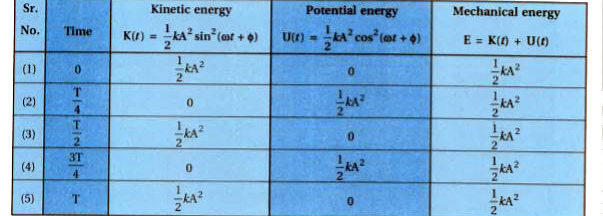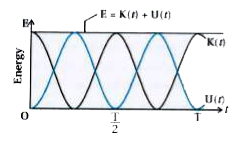Explain and draw the graphs of kinetic energy, potential energy and total energy as a function of time.Solution in Gujrati
Kinetic energy of SHM particle
K(t)=12kA2sin2(ωt+ϕ)
Potential energy U(t)=kA2cos2(ωt+ϕ)
Mechanical energy E=K(t)+U(t)
∴12kA2[sin2(ωt+ϕ)+cos2(ωt+ϕ)]
∴E=12kA2.
Here, in table values of kinetic, potential and total energy in terms of period of SHM particle is shown and by using these values a graph of a energy versus time is shown.


Following points are clear from this graph : (1) In SHM both kinetic and potential energy are positive hence total energy is also positive.
(2) In SHM, kinetic energy becomes two time maximum in every period and becomes two times zero. This maximum kinetic energy is equal to the total energy.
(3) In SHM, potential energy becomes two times maximum in every period and become two time zero. This maximum potential energy is eaual to the total energy.
(4) The increase or decrease in kinetic energy from energy time of T4 in SHM is equal to decrease or increase in potential respectively.
(5) At any time the sum of kinetic and potential energy is constant and it is mechanical energy. Hence mechanical energy does not depend on time.
Topper's Solved these Questions
- OSCILLATIONSBOOK - KUMAR PRAKASHANCHAPTER - OSCILLATIONSEXERCISE - SECTION-A (TRY YOURSELF)
64 Videos
- OSCILLATIONSBOOK - KUMAR PRAKASHANCHAPTER - OSCILLATIONSEXERCISE - SECTION-B (NUMERICAL FROM TEXTUAL ILLUSTRATIONS)
40 Videos
- OBJECTIVE QUESTIONS AS PER NEW PAPER STYLE BOOK - KUMAR PRAKASHANCHAPTER - OBJECTIVE QUESTIONS AS PER NEW PAPER STYLE EXERCISE - CHAPTER - 8 (Match Type questions)
5 Videos
- PHYSICAL WORLDBOOK - KUMAR PRAKASHANCHAPTER - PHYSICAL WORLDEXERCISE - SECTION-E (QUESTIONS FROM MODULE)
9 Videos
Similar Questions
What is motion ?
View SolutionOn an average, a human heart is found to beat 75 times in a minute. Calculate its frequency and period.
View SolutionType of satellites are given in Column-I and their uses are given in Column-II. Match them properly :
Column-IColumn-II(1) Polar satellite(a) Tele communication(2) Geo-stationary satellite(b) Investigation(c) For information about atmosphere
View Solution.…. state of substance at very high temperature has generated hope of energy source for mankind.
View SolutionAt time t , the kinetic energy of a particle is 30.0J and the potential energy of the system to which it belongs is 10.0J . At some later time t_f , the kinetic energy of the particle is 18J , what are the potential energy and the total energy at time t_f ? If the potential energy of the system at time t_3 is 5.00J , are any non-conservative forces acting on the particle? Explain.
View SolutionAssertion : The graph of potential energy and kinetic energy of a particle in SHM with respect to position is a parabola. Reason : Potential energy and kinetic energy do not vary linearly with position.
View Solutionजिस समय विस्थापन , आयाम का आधा है , कुल ऊर्जा का कितना अंश गतिज ऊर्जा तथा कितना अंश स्थितिज ऊर्जा होगा ?
View SolutionFind the expression for kinetic energy, potential energy and total energy in simple harmonic motion. Show the variation of kinetic energy, potential energy and total energy with (i) time and (ii) displacement graphically.
View SolutionDraw a plot of potential energy of a pair of nucleons as a function of their separation. What is the significance of negative potential energy in the graph drawn ?
View SolutionExplain and draw the graphs of kinetic energy, potential energy and mechanical energy versus displacement for SHM.
View SolutionIf any satellite has kinetic energy 6 xx 10^(9)J , then what its potential energy ? Total energy?
View Solution(A) : The graph of potential energy and kinetic energy of a particle in SHM with respect to position is a parabola.
(R) : Potential energy and kinetic energy do not vary linearly with position.
View Solution(A) : The graph of potential energy and kinetic energy of a particle in SHM with respect to position is a parabola. (R) : Potential energy and kinetic energy do not vary linearly with position.
View SolutionRepresent graphically the variations of potential energy, kinetic energy and total energy as a function of position 'y' for a simple harmonic oscillator. Explain the graph.
View SolutionWhat is energy, Explain kinetic and potential energies.
View Solution
